Website owner: James Miller
DIFFERENTIATION, IMPLICIT DIFFERENTIATION, DERIVATIVES OF HIGHER ORDER, INFLECTION POINTS, CRITICAL POINTS, MAXIMA AND MINIMA
The process of differentiation involves applying the various differentiation rules and formulas (the main ones having been memorized) to the function for which we want the derivative.
Differentiation examples.
Problem 1. Find the derivative of y = 8x4 + 5x2 - 9x
Solution.
![]()
![]()
= 8(4x3) + 5(2x) - 9(1) (by Rule 10)
= 32x3 + 10x - 9
Problem 2. Find the derivative of y = sin 3x + cos 2x.
Solution.
![]()
= 3 cos 3x - 2 sin 2x
Problem 3. Find the derivative of
![]()
Solution.

![]()
Problem 4. Find the derivative of e-x ln x.
Solution.
![]()
![]()
![]()
Implicit differentiation. An equation of the form y = f(x) is said to define y as an explicit function of x. When y is given as an explicit function of x there is no difficulty in obtaining dy/dx using our rules and formulas for differentiating functions. If, however, y is given as an implicit function of x through an equation of the form f(x, y) = 0 it may be inconvenient or impossible to solve the equation for y in terms of x. There is, nonetheless, a method of finding dy/dx without solving the equation for y. The method is called implicit differentiation. In general, for implicit functions, the method of implicit differentiation is the most convenient and practical method to use for differentiating.
The method consists in 1. Differentiating the equation as it stands with respect to x, regarding y as an unknown function of x having a derivative dy/dx, and 2. Solving the resulting equation for dy/dx. We illustrate with an example.
Problem. Given equation
1) x3 + 5x2 + xy2 - 5y2 = 0.
Find dy/dx.
Solution.
Step 1. Differentiate each term of the equation with respect to x regarding, y as an unknown function of x:
![]()
![]()
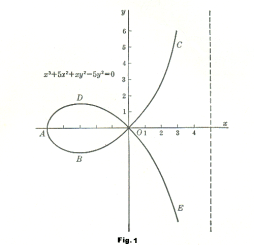
Step 2. Regard dy/dx as the unknown and solve the equation by the usual methods.
![]()
![]()
![]()
A graph of equation 1) is shown in Fig. 1. At any point that we choose on the locus of the equation the value of dy/dx will be given by 2).
Derivatives of Higher Order. The derivative dy/dx of a function y = f(x) is itself a function of x. Thus its derivative can be found in turn. It is called the second derivative of the function. Similarly the derivative of the second derivative is called the third derivative, and so on for still higher derivatives.
Notations for higher order derivatives.
Second derivative:
![]()
Third derivative:
![]()
N-th derivative:
![]()
Note. The derivative of a given order at a point can exist only when the function and all derivatives of lower order are differentiable at the point.
Example.
![]()
![]()
![]()
Successive differentiation of implicit functions. Suppose y is defined implicitly as a function of x in an equation of the form f(x, y) = 0 where y cannot be solved for x and one wishes to compute higher order derivatives of y with respect to x. We can do so using the method of implicit differentiation. The following example illustrates the technique.
Problem. Given the equation x2 - y2 = a2. Find
![]()
Solution.
![]()
![]()

Now take the derivative of 2):

Substituting in the value of dy/dx = x/y from 2) we get


All admissible values of x and y must satisfy the original equation x2 - y2 = a2. Consequently we can replace y2 - x2 by -a2 and write the result in the simpler form

Taking the third derivative with respect to x we get



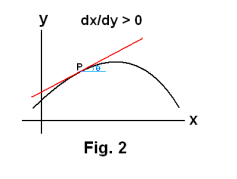
Then using the fact that dy/dx = x/y, we get

Signs of the first and second derivatives. We now consider the meanings of positive and negative values for dy/dx and d2y/dx2.
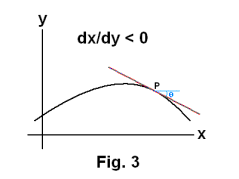
dy/dx is positive. The curve rises with increasing x. The tangent line has a positive slope. See Fig. 2. The inclination angle θ is positive.
dy/dx is negative. The curve drops with increasing x. The tangent line has a negative slope. See Fig. 3. The inclination angle θ is negative.
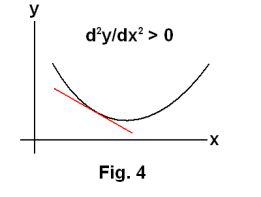
d2y/dx2 is positive. The slope is increasing as x increases. The tangent line turns in a counterclockwise manner as it traverses the curve from left to right. The arc is concave upwards. The tangent line lies below the curve. See Fig. 4.
d2y/dx2 is negative. The slope is decreasing as x increases. The tangent line turns in a clockwise manner as it traverses the curve from left to right. The arc is concave downwards. The tangent line lies above the curve. See Fig. 5.
In Fig. 6 we see the graph of the function
y = x3 - 3x2 + 6 .
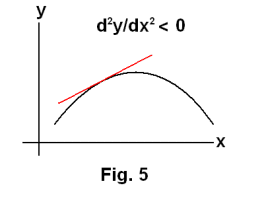
On the arc AMP the value of d2y/dx2 is negative and on the arc PNB it is positive. Point P where it changes form negative to positive is an inflection point.
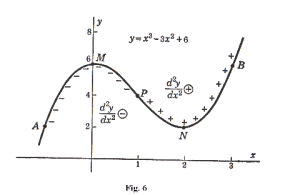
Inflection point. An inflection point on a curve is a point at which the second derivative d2y/dx2 changes sign (i.e. from negative to positive or positive to negative). Thus it is a point at which the concavity of the curve changes (from upward concavity to downward concavity or vice versa). In general, d2y/dx2 = 0 at inflection points. However, it is possible for a curve to have an inflection point at which d2y/dx2 is not equal to zero. This can only happen, however, if the second derivative fails to exist at such a point. Such points can be discovered by studying the behavior of the curve in the neighborhood of any points at which d2y/dx2 becomes infinite or otherwise fails to exist. An example of a curve with an inflection point where d2y/dx2 is not equal to zero is the curve
![]()
shown in Fig. 7. The derivatives are
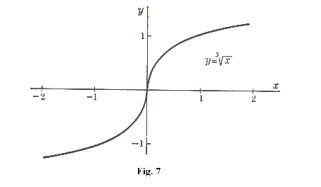
![]()
![]()
There is no value of x for which d2y/dx2 = 0, but the derivative fails to exist at x = 0. The point (0, 0) is an inflection point. To the left of the point d2y/dx2 is positive and the curve is concave upward and to the right of the point d2y/dx2 is negative and the arc is concave downward.
Def. Critical (or stationary) point. A critical (or stationary) point of a function y = f(x) is a point at which dy/dx = 0. It corresponds to a point on the curve at which the tangent to the curve is horizontal.
● In general, a critical point represents either a maximum point, a minimum point or an inflection point.
Def. Critical value of x. A value of x at which a critical point occurs i.e. a point at which dy/dx = 0. All roots of f '(x) = 0 are critical values of x.
Maxima and minima. A function y = f(x) has a maximum at a point x0 if f(x0)
![]() f(x)
for all points in the neighborhood of x0. Such a function has a minimum at a point x0 if f(x0)
f(x)
for all points in the neighborhood of x0. Such a function has a minimum at a point x0 if f(x0)
![]() f(x) for all points in the neighborhood of x0.
f(x) for all points in the neighborhood of x0.
Necessary condition for a maxima or minima. Generally speaking, a necessary condition for a function y = f(x) to have a maximum or minimum at a point is that dy/dx = 0 at the point. However, there is an exception. In Fig. 8 point E represents an exception. At point E dy/dx doesn’t exist. Maxima or minima can occur at points at which dy/dx doesn’t exist.
Referring to Fig. 8:
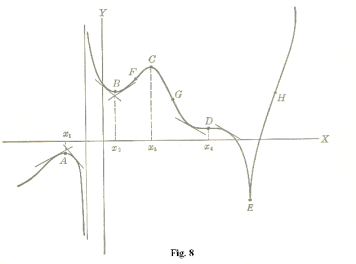
● A, B, C, D are critical (or stationary) points; dy/dx = 0 at each point A, B, C, D
● x1, x2, x3, x4 are critical values of x
● A and C are maximum points
● B and E are minimum points
● F, G, D and H are inflection points
Procedure for determining maxima and minima. In locating maximum and minimum points we utilize the following fact: The slope is positive immediately before (to the left of) a maximum point and negative immediately after one. For a minimum point, the slope is negative before and positive after.
To determine the maximum and minimum points of y = f(x):
1. Solve f '(x) = 0 for the critical values of x.
2. Apply either the first derivative test or second derivative test:
First derivative test:


If neither (a) nor (b) holds, then the point in question is neither a maximum nor a minimum but a point of inflection with a horizontal tangent.
Second derivative test:
f ''(x1) < 0 — Maximum point
f ''(x1) > 0 — Minimum point
If f ''(x1) = 0, the test fails and the point might or might not be a maximum or minimum. In this case we can proceed as follows. Let
f '(x1) = f ''(x1) = f ''' (x1) = ... = f [n -1](x1) = 0,
f n(x1)
![]() 0.
0.
Then
(a) n is even. If f n(x1) < 0, point is a maximum
If f n(x1) > 0, point is a minimum
(b) n is odd. Point is neither a maximum nor a minimum.
Example. Find the maxima and minima of
y = 2x3 + 3x2 - 12x - 15
See Fig. 9.
Solution.
y' = 6x2 + 6x - 12
= 6(x+2)(x - 1) = 0
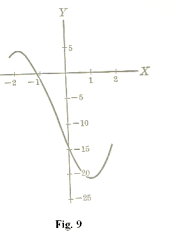
Critical values: x = -2, 1
First derivative test for x = -2 :
y' > 0 before, y' < 0 after
Thus x = -2 corresponds to a maximum point.
First derivative test for x = 1 :
y' < 0 before, y' > 0 after
So x = 1 corresponds to a minimum point.
Jesus Christ and His Teachings
Way of enlightenment, wisdom, and understanding
America, a corrupt, depraved, shameless country
On integrity and the lack of it
The test of a person's Christianity is what he is
Ninety five percent of the problems that most people have come from personal foolishness
Liberalism, socialism and the modern welfare state
The desire to harm, a motivation for conduct
On Self-sufficient Country Living, Homesteading
Topically Arranged Proverbs, Precepts, Quotations. Common Sayings. Poor Richard's Almanac.
Theory on the Formation of Character
People are like radio tuners --- they pick out and listen to one wavelength and ignore the rest
Cause of Character Traits --- According to Aristotle
We are what we eat --- living under the discipline of a diet
Avoiding problems and trouble in life
Role of habit in formation of character
Personal attributes of the true Christian
What determines a person's character?
Love of God and love of virtue are closely united
Intellectual disparities among people and the power in good habits
Tools of Satan. Tactics and Tricks used by the Devil.
The Natural Way -- The Unnatural Way
Wisdom, Reason and Virtue are closely related
Knowledge is one thing, wisdom is another
My views on Christianity in America
The most important thing in life is understanding
We are all examples --- for good or for bad
Television --- spiritual poison
The Prime Mover that decides "What We Are"
Where do our outlooks, attitudes and values come from?
Sin is serious business. The punishment for it is real. Hell is real.
Self-imposed discipline and regimentation
Achieving happiness in life --- a matter of the right strategies
Self-control, self-restraint, self-discipline basic to so much in life